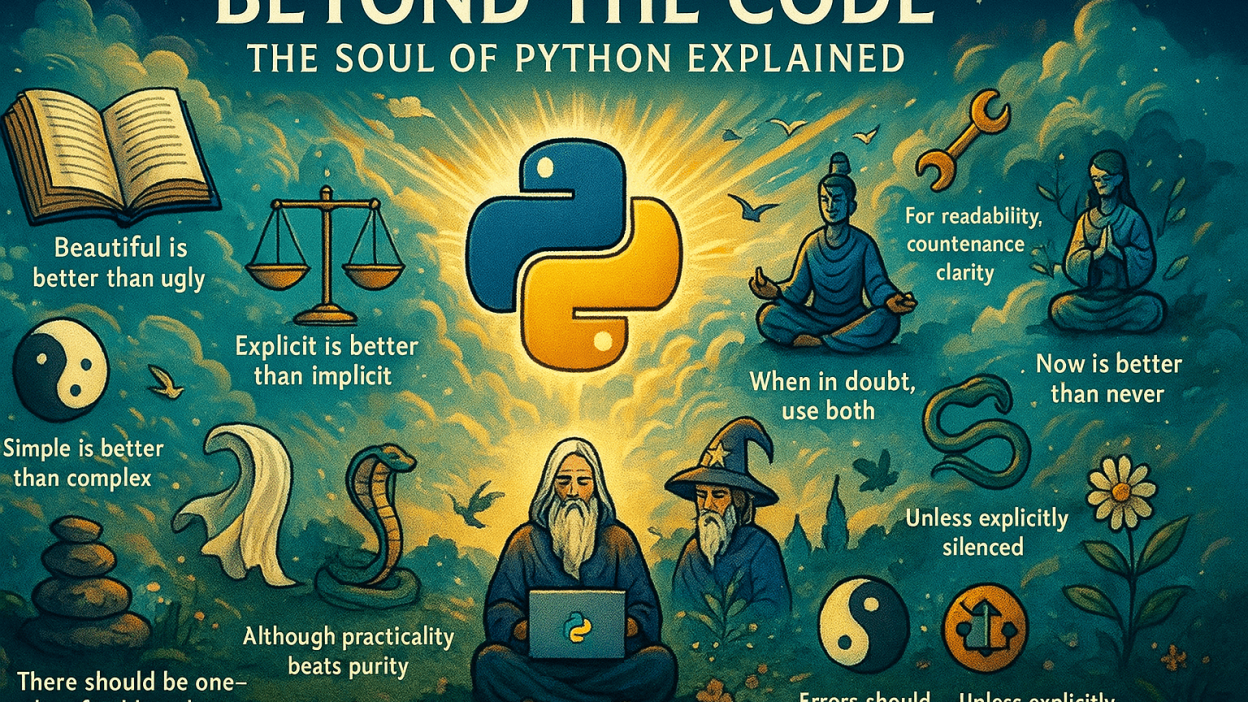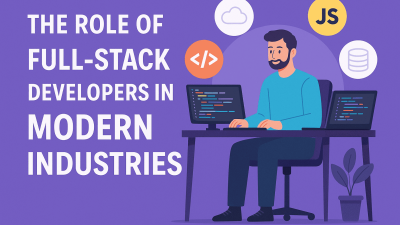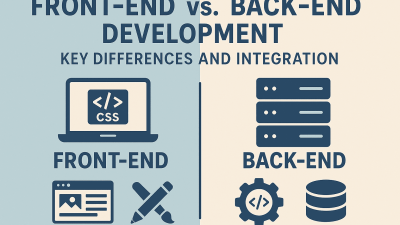You’ve probably heard it before: Python is readable, Python is intuitive, Python feels… different. This isn’t by accident. It’s by design.
Tucked away inside every Python interpreter is a secret manifesto—a concise set of 19 guiding principles written by software engineer Tim Peters that has shaped the language for decades. It’s called the Zen of Python, and you can reveal it at any time by typing import this.
But what does it actually mean? Let’s break down this philosophy and see how it translates into writing code you can actually be proud of.
The Core Philosophy: Clarity is King
At its heart, the Zen of Python is a love letter to readability. It argues that the time other developers (including your future self) spend reading your code vastly outweighs the time you spent writing it. Therefore, the highest goal isn’t to be clever; it’s to be clear.
To truly write Pythonic code—code that is not just functional but elegant, maintainable, and a joy to work with—one must internalize these tenets. Let’s dissect each principle, exploring its practical implications and how it manifests in real-world code.
1. Beautiful is better than ugly.
In Depth: This principle elevates code from a mere set of instructions to a form of expression. “Beauty” in code is achieved through:
- Symmetry and Structure: Consistent indentation, thoughtful spacing, and logical grouping of related code.
- Elegant Algorithms: Choosing solutions that are not only correct but also intellectually satisfying and efficient.
- Meaningful Names: Using descriptive names for variables (customer_id instead of c), functions (calculate_tax() instead of proc()), and classes (HttpRequestHandler instead of Handler).
Example:
Ugly:
x = [i for i in range(10) if i % 2 == 0] # What is this for?Beautiful:
even_numbers = [number for number in range(10) if number % 2 == 0]
# The purpose is immediately clear.2. Explicit is better than implicit.
In Depth: Code should be self-documenting. The reader should never have to guess about the origin, type, or behavior of a variable or function. This reduces cognitive load and prevents subtle bugs.
- Avoid “Magic”: Discourage practices like from module import * which pollute the namespace implicitly.
- Clear Function Contracts: Functions should have clear inputs and outputs. Using type hints (def greet(name: str) -> str:) is a powerful way to be explicit.
- Obvious Source: It should always be clear where an object or function is defined.
3. Simple is better than complex.
In Depth: The goal is to find the most straightforward solution to the problem. Complexity introduces more points of failure and makes code harder to reason about. Before building a elaborate framework, ask: “What is the simplest thing that could possibly work?”
4. Complex is better than complicated.
In Depth: This is a crucial nuance. Some problems are inherently complex (e.g., a distributed consensus algorithm, a physics engine). A complex solution to a complex problem is acceptable.
A complicated solution, however, is one that is unnecessarily convoluted. It’s often the result of over-engineering a simple problem or introducing accidental complexity through poor design.
- Complex: A sophisticated neural network architecture.
- Complicated: A 500-line “God function” that tries to handle every possible edge case for parsing a simple configuration file in a single, nested block.
5. Flat is better than nested.
In Depth: Deeply nested code (e.g., if inside for inside if inside try) is a primary source of complexity and bugs. It’s mentally challenging to track all the logical paths (“arrowhead code”).
- Solution: “The Bouncer Pattern”: Use guards and early returns to flatten logic. Check for error conditions or edge cases first and return or raise an exception immediately, allowing the “happy path” to remain at the top level without deep nesting.
Example:
Nested (bad):
def process_data(data):
if data is not None:
for item in data:
if item.is_valid():
# ... 10 lines of logic deep inside 3 nestsFlat (better):
def process_data(data):
if data is None:
return
for item in data:
if not item.is_valid():
continue # Skip invalid items, focus on the happy path
# ... process valid item at a shallow indentation level6. Sparse is better than dense.
In Depth: Don’t cram too much functionality onto a single line. This improves readability by giving the eye clear landmarks. Use whitespace to separate logical blocks of code.
- Avoid: result = [x**2 for x in lst if x%2==0]; print(result)
- Prefer: Break complex one-liners into multiple steps or lines.
7. Readability counts.
In Depth: This is the single most important principle, the one upon which all others hinge. It’s a constant reminder that you are writing for a human audience. Readable code is debuggable, maintainable, and extendable. It reduces the cost of change over the software’s lifetime.
8. Special cases aren’t special enough to break the rules.
In Depth: Consistency is paramount. While a special case might tempt you to violate a design pattern or naming convention, resist. Consistency makes the codebase predictable and easier to navigate. The value of a uniform approach across the entire project outweighs the minor convenience of a one-off hack.
9. Although practicality beats purity.
In Depth: This is the essential counterbalance to the previous rule. It’s the acknowledgment that we are engineers, not philosophers. If adhering strictly to a principle (like “no code duplication”) leads to an absurdly complex abstract solution, the practical choice is to break the rule.
- Example: A little repeated code is often better than a convoluted inheritance hierarchy or a metaprogramming trick that saves five lines but takes two hours for anyone to understand.
10. Errors should never pass silently.
In Depth: Silent failures are the most dangerous kind. They allow a program to continue in an invalid state, corrupting data and making the ultimate source of the problem incredibly difficult to trace. An error that crashes the program is far better than one that hides.
11. Unless explicitly silenced.
In Depth: The only time to silence an error is when you are absolutely certain it is safe to do so, and you must do it explicitly. This means:
- Catching a specific exception (e.g., except ValueError:), never a bare except:.
- Handling it appropriately, even if that just means logging it.
- Documenting why it’s being silenced with a comment.
Example:
try:
value = int(user_input)
except ValueError:
# Explicitly silence expected ValueError from non-numeric input.
# Default to 0 as per business logic requirement.
value = 0
logger.info("Defaulted invalid input %r to 0", user_input)12. In the face of ambiguity, refuse the temptation to guess.
In Depth: This principle is built into Python’s core design. The language syntax is designed to be unambiguous. As a developer, you should extend this philosophy:
- API Design: Your functions should not try to “be smart” with different input types if it’s not explicit. Raise clear errors for invalid input.
- User Input: Never guess what a user meant. Validate input and ask for clarification if needed.
- Code Interpretation: If code is ambiguous, refactor it until it’s clear. Don’t leave it for the next person to guess.
13. There should be one– and preferably only one –obvious way to do it.
In Depth: This is a direct contrast to Perl’s “TMTOWTDI” (There’s More Than One Way To Do It). Python values consistency and community standards. For common tasks, there is usually an idiomatic way—a way that is accepted by the community as the best practice (e.g., using for item in list: for iteration). This reduces decision fatigue and makes any Python codebase familiar to any Python developer.
14. Although that way may not be obvious at first unless you’re Dutch.
In Depth: A lighthearted joke acknowledging Guido van Rossum’s role as the language’s Benevolent Dictator For Life (BDFL). It hints that the “one obvious way” might be obvious first to the language’s creator, but the community eventually converges on it through practice and documentation (like PEP 8).
15. Now is better than never.
In Depth: This is a call to action against “analysis paralysis.” It’s better to start with a simple, good-enough solution and iterate (Now) than to get stuck in endless planning without writing any code (Never). It aligns with agile and iterative development philosophies.
16. Although never is often better than right now.
In Depth: Another critical counterbalance. While starting is important, rushing (*right* now) is disastrous. Hasty, poorly thought-out code creates technical debt that takes far longer to fix later. The wisdom is in finding the balance: start now, but with careful thought, and be prepared to refactor later. Think about the design before you code.
17 & 18. If the implementation is hard to explain, it’s a bad idea. / If the implementation is easy to explain, it may be a good idea.
In Depth: This is the ultimate litmus test for your code’s design. The ability to explain your code is a proxy for its clarity and simplicity.
- “Hard to explain” code is often overly clever, uses complex patterns inappropriately, or is poorly structured. If you struggle to articulate how it works, it will be a nightmare to debug and maintain.
- “Easy to explain” code uses clear abstractions and straightforward logic. You can describe it to a colleague at a whiteboard without getting tangled in exceptions and edge cases. This is a strong indicator of a good design.
19. Namespaces are one honking great idea — let’s do more of those!
In Depth: This celebrates one of Python’s most fundamental organizational features. Namespaces (modules, packages, classes, functions) are containers that prevent naming conflicts and provide context.
- math.sqrt vs. numpy.sqrt – the namespace makes it clear which implementation you’re using.
- They allow for logical grouping of related functionality.
- They make large codebases manageable. This principle encourages you to use them liberally: break code into modules, use classes to encapsulate data and behavior, and avoid polluting the global namespace.
Conclusion: A System of Balanced Wisdom
The true genius of the Zen of Python is not in its individual rules, but in their interplay. It provides paired principles that create a system of checks and balances:
- Rules are important… but practicality beats purity.
- Start now… but don’t rush.
It’s a philosophy that guides developers toward writing code that is not just effective, but respectful—respectful of the future developers who will read it, and ultimately, respectful of the problem itself.



